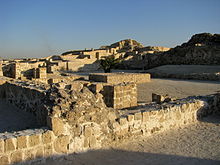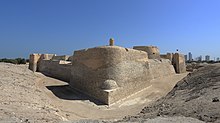Qalʿat al-Bahrain
Coordinates: 26 ° 14 ′ 1 ″ N , 50 ° 31 ′ 14 ″ E
Qalʿat al-Bahrain ( Fort of Bahrain ; Arabic قلعة البحرين Qalʿat al-Baḥrain ) is the name of an archaeological site in Bahrain . The hill of ruins is approx. 300 × 600 m and was probably the main town on the island for a long time. In 2005 it was included in the UNESCO World Heritage List .
The lowest layers date to around 2200 BC. And belong to a city complex of the Dilmunkultur with a city wall and large house complexes that had storage facilities. Around 1450 BC A large Kassite palace was built here, in which a governor probably resided. Numerous cuneiform tablets come from here. The only one dated is from the 4th year of King Agum's reign. Most researchers assume that it is Agum III. acts. Ili-ippašra , a Kassite governor of Dilmun, is already known from the reign of Burna-buriaš II . The governor's palace finally burned down and the administration may have been moved to Failaka . From the 10th to the 5th century BC, there are other large house complexes with sanitary facilities and burials under the floors.
Even in the Hellenistic period (3rd century BC) the city was densely populated, but these layers are not very well preserved. In the third century AD, an approx. 51.5 x 51.5 m fortress was built, which is probably connected with the takeover of power by the Sassanids . Dense development in the city is also documented for the Islamic Middle Ages. The Portuguese subjugated Bahrain in the 16th century and controlled maritime trade in the Persian Gulf from 1521 to 1602 with their ships and some fortifications along the coast. In the 16th century, a large Portuguese fort was built in the place of the city , which still dominates the place today.
Excavations took place from 1954 to 1970 under the direction of a Danish mission led by Geoffrey Bibby . A French mission has been digging here since 1978 and a local team since 1987.
Web links
Individual evidence
- ^ B. André-Salvini, P. Lombard, La découverte épigraphique de Qal'at al-Bahreïn: un jalon pour la chronologie de la phase Dilmoun moyen dans le Golfe arabe. Proceedings of the Seminar for Arabian Studies 27, 1997, 167
- ↑ DT Potts, Elamites and Kassites in the Persian Gulf. Journal of Near Eastern Studies 65/2, 2006, 116



